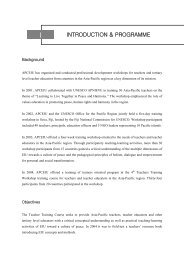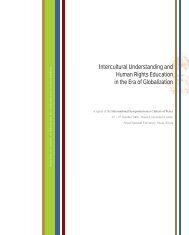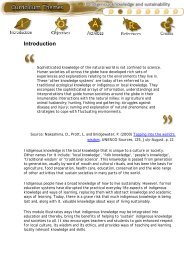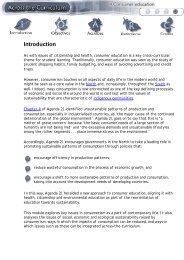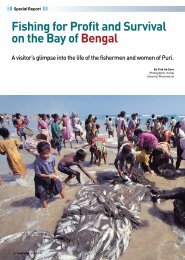REPORT OF UNESCO EXPERT MEETING ON - APCEIU
REPORT OF UNESCO EXPERT MEETING ON - APCEIU
REPORT OF UNESCO EXPERT MEETING ON - APCEIU
You also want an ePaper? Increase the reach of your titles
YUMPU automatically turns print PDFs into web optimized ePapers that Google loves.
studied in any order to suit the interests and needs of users.<br />
Range of activities<br />
Each of the modules contains 5 to 7 ‘activities’, each one usually requiring between 30 and 40 minutes to<br />
complete. The personal Learning Journal integrated into the programme allows busy users to ‘save’ their<br />
work after one or two activities and come back to the module when they have more time. These activities<br />
provide a full multimedia learning experience. Passive reading is minimal. Most time is spent answering<br />
questions, doing exercises, working through problems, games and other activities that encourage active<br />
learning.<br />
Easy to use<br />
User friendliness is reinforced by using a common presentation for all 25 modules. Each module is<br />
organized under the same headings - introduction, objectives, activities, references and credits, common<br />
design elements (e.g. navigation bars and icons). Simple and clear instructions are provided throughout.<br />
Simplicity of design<br />
Teaching and Learning for a Sustainable Future has a simple visual design, based on an attractive range of<br />
colours and icons. The programme is free of the large files and complex graphics that increase download<br />
time and cost of Internet access. The programme can operate on a computer with relatively simple hardware<br />
specifications. No prior knowledge or skills is required. The clear instructions guide users step by step<br />
through the programme.<br />
Learning styles<br />
The many different types of professional development activities integrated into Teaching and Learning for a<br />
Sustainable Future provide a rich variety of learning experiences that cater to many learning styles. Long<br />
passages have been kept to a minimum – and when they do appear – are mostly located in pop-up boxes and<br />
can even be printed and read when convenient. Great care has been given to providing information in a<br />
variety of forms (e.g. text, tables, diagrams, audio-files and linked Internet-sites). The activities require<br />
users to analyse and interpret this information and to apply the ideas learnt to local curriculum and teaching<br />
contexts. A Learning Journal allows users to summarise questions, answers and reflections and save them in<br />
a word processing programme.<br />
Adaptable<br />
An ‘open architecture’ (i.e. technical structure) was used to create the computer files in Teaching and<br />
Learning for a Sustainable Future. For this reason, the programme can be easily translated or adapted with a<br />
minimum of technical expertise and a basic webpage creation application. See following sections for some<br />
suggestions for adapting Teaching and Learning for a Sustainable Future to different educational and<br />
cultural contexts.<br />
165



